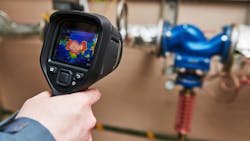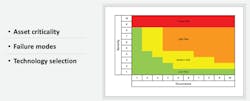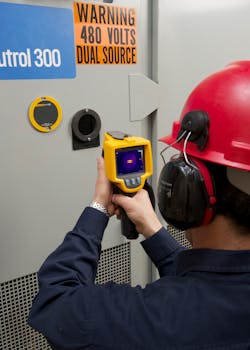How thermal imaging can make preventive maintenance safer and more efficient
Preventive maintenance is intended to reduce unplanned downtime and improve safety. Most maintenance programs currently utilize thermal imaging as one of many technologies to inspect and monitor critical equipment. Using the right thermal tools and software as part of a maintenance route can catch the heat generated from degrading components.
This article outlines five steps you can take to get even more impact for your program.
1. Establish an asset health management database
Start by establishing an asset health database to document and prioritize equipment. Building out a database of your assets and equipment, including asset criticality, failure modes, and tools to inspect with, is a good starting point to improve any maintenance program. Leverage your computerized maintenance management system (CMMS), OEM guidelines for operation and maintenance, as well as applicable industry standards to determine the method and frequency of asset condition monitoring inspections (see Figure 1).
2. Establish procedures and routes for consistency
Next, establish written procedures regarding how and when to inspect; this can include certain routes to take to ensure that the data is consistent and can lead you to a proper assessment. Written procedures, which define the conditions, frequency, location, and method of thermal inspections, are critical for consistency and quality of the data. Current industry standards should be reviewed during this step to take safety measures into account, and properly define equipment and PPE.
3. Compare baseline thermal images of known good equipment to the current inspection.
]Thermal imaging is a key technology in asset health because, for most assets, failure modes generate heat as the component degrades. Having baseline thermal images of known good operating equipment is critical to evaluating the condition/health of an asset. With this, you can compare the relative difference of a current thermal image of an asset to the baseline thermal image for valuable insight. In most cases, it is this relative temperature difference from normal operation which is most useful to assessing health. Since baseline data is so important, consider including thermal inspections as a standard part of qualifying new equipment or when troubleshooting issues.
4. Store, analyze, and share the data in real time with thermal imaging software
Thermal imaging hardware and software can make a significant difference in whether a program is effective or not. When designed well, the hardware and software work in harmony with the procedures to make taking, organizing, storing, and evaluating images a simple and efficient process. Camera features can aid in capturing a quality image and can also add other metadata which will be used to organize and evaluate the image later.
Some thermal imaging solutions can even provide routes, step by step instructions, and baseline images on the fly to ensure inspection compliance and consistency. Decisions on asset health and maintenance needs can be made and communicated to other team members at the point of inspection in real-time. The software can also do the heavy lifting of uploading and organizing images as well as preparing standard reports. When used together, these actions build a new level of efficiency to thermal imaging and the maintenance program itself.
5. Use and install the right thermal imaging tools
Thermal cameras are non-contact tools designed to be used from a distance, allowing you to remain outside of an arc flash boundary or other unsafe condition whenever possible. Where that’s not possible, thermal imaging accessories like accessory lenses and IR windows can give you the access to inspections with an additional layer of safety.
- Lenses. Some thermal cameras allow for interchangeable lenses. Tailor the view you want by switching to a wide-angle or telephoto lens.
- IR Windows. IR windows are permanently installed into the side of a panel to provide a means to view inside and capture thermal images of important equipment without exposing workers to dangerous live voltage (see Figure 2). This both improves safety and creates a more consistent process to assess the asset. Because of the permanent nature of the window, a thermal camera can be positioned consistently, enabling you to build a baseline and a trendline as well as a collection of images showing the asset.
By choosing the proper thermal tools and software, the effectiveness, efficiency, and safety of the inspections themselves as well as the maintenance actions taken from those inspections can be greatly enhanced.
About the Author
Justin Sheard
Fluke
Justin Sheard is a senior engineer and application specialist with the Fluke Industrial Imaging group. He has more than 20 years of experience designing handheld electronic products. While holding leadership roles in the development of Fluke thermal imagers, Sheard accumulated more than 10 patents. In his current position as application specialist, Sheard works directly with customers offering training and application support while learning about their workflows and daily challenges. Sheard holds a Master of Science in Mechanical Engineering from University of Minnesota and a Bachelor of Science in Physics from Bethel University.


